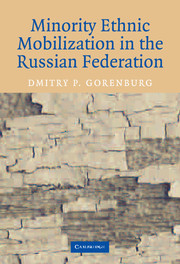Book contents
- Frontmatter
- Contents
- List of Figures and Tables
- Preface
- 1 Minority Ethnic Mobilization in Russia: An Introduction
- 2 Explaining Ethnic Mobilization: The Role of Ethnic Institutions
- 3 From Cultural Society to Popular Front: The Formation and Development of Nationalist Organizations
- 4 The Soviet Institutional Legacy and Ethno-Nationalist Ideology
- 5 Institutions Matter: Measuring Support for Nationalism
- 6 Intragroup Variation in Support for Nationalism: Not All Ethnics Are the Same
- 7 Outcomes: Did Regional Governments Adopt the Nationalist Agenda?
- 8 The Larger Picture: Support for Nationalism in Russia's Other Republics
- 9 Institutions and Nationalism
- Appendix: Construction of Variables and Indices
- References
- Index
5 - Institutions Matter: Measuring Support for Nationalism
Published online by Cambridge University Press: 15 December 2009
- Frontmatter
- Contents
- List of Figures and Tables
- Preface
- 1 Minority Ethnic Mobilization in Russia: An Introduction
- 2 Explaining Ethnic Mobilization: The Role of Ethnic Institutions
- 3 From Cultural Society to Popular Front: The Formation and Development of Nationalist Organizations
- 4 The Soviet Institutional Legacy and Ethno-Nationalist Ideology
- 5 Institutions Matter: Measuring Support for Nationalism
- 6 Intragroup Variation in Support for Nationalism: Not All Ethnics Are the Same
- 7 Outcomes: Did Regional Governments Adopt the Nationalist Agenda?
- 8 The Larger Picture: Support for Nationalism in Russia's Other Republics
- 9 Institutions and Nationalism
- Appendix: Construction of Variables and Indices
- References
- Index
Summary
Support for social movements can be expressed in several different ways. Active supporters join movement organizations and participate in protest activities. More passive forms of participation include voting for the movement's candidates in elections and voicing support for movement goals in polls and surveys. This chapter measures the extent of popular support for nationalist movements by analyzing the full range of these activities. The highest levels of both passive and active support for ethno-nationalist mobilization are found in Tatarstan and Bashkortostan, with somewhat lower levels of support in Chuvashia. Nationalism finds the fewest adherents in Khakassia, the former autonomous province.
Protest activity is the most demanding way of demonstrating support for a political cause. Unlike voting and responding to surveys conducted by social scientists, public protest runs the risk of repression by an unsympathetic government or injury in clashes with movement opponents. Therefore, this form of movement activity attracts the smallest number of supporters and is most easily influenced by government and opposition actions. In examining protest activity, I focus on demonstrations, hunger strikes, and violent clashes as the most visible and galvanizing forms of protest.
Because of their novelty and their importance as an immediate and authoritative measure of public support, nationalist movements saw electoral politics as a central arena for testing their strength against other political forces in the regions.
- Type
- Chapter
- Information
- Minority Ethnic Mobilization in the Russian Federation , pp. 118 - 166Publisher: Cambridge University PressPrint publication year: 2003



